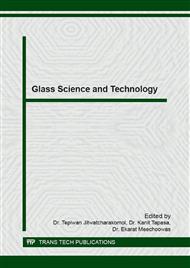[1]
C.K. Jayasankar, C.R. Kesavulu, K.K. Kumar, N. Vijaya, K.S. Lim, Thermal, vibration and optical properties of Eu3+-doped lead fluorophosphates glasses for red laser applications, Mater. Chem. Phys. 141 (2013) 903-911.
DOI: 10.1016/j.matchemphys.2013.06.021
Google Scholar
[2]
J. Pisarska, M. Soltys, L. Zur, W.A. Pisarski, C.K. Jayasankar, Excitation and luminescence of rare earth-doped lead phosphate glasses, Appl. Phys. B. 116 (2014) 837-845.
DOI: 10.1007/s00340-014-5770-9
Google Scholar
[3]
F. Zhang, Z. Xiao, L. Yan, F. Zhu, A. Huang, Visible luminescence properties of Er3+-Dy3+ codoped tellurite glasses, Appl. Phys. A. 101 (2010) 777-780.
DOI: 10.1007/s00339-010-5966-8
Google Scholar
[4]
Y.C. Ratnakaram, M.D. Naidu, D. Rajesh, A. Balakrishna, Kinetic of fluorescence properties of Eu3+ ion in strontium-aluminium-bismuth-borate glasses, J. Rare. Earth. 32 (2014) 1140-1147.
DOI: 10.1016/s1002-0721(14)60195-2
Google Scholar
[5]
Y.C. Ratnakarm, A. Balakrishna, D. Rajesh, Structural and optical properties of Nd3+ in lithium fluoro-borate glass with relevant modifier oxides, Opt. Mater. 35 (2013) 2670-2676.
DOI: 10.1016/j.optmat.2013.08.004
Google Scholar
[6]
B.S. Reddy, K.V. Raju, C.N. Raju, B. Sailaja, Judd-ofelt analysis and photoluminescence properties of RE3+ (RE=Er & Nd): cadmium lithium boro tellurite glasses, Solid. State. Sci. 15 (2013) 102-109.
DOI: 10.1016/j.solidstatesciences.2012.08.011
Google Scholar
[7]
X. Li, Q. Nie, S. Dai, T. Xu, Y. Chen, X. Zhang, Investigation of 1. 3μm emission in Nd3+-doped bismuth-base oxide glasses. Phys. B. 400 (2007) 88-92.
DOI: 10.1016/j.physb.2007.06.021
Google Scholar
[8]
S.P. Singh, R.P.S. Chakradhar, J.L. Rao, B. Karmarkar, EPR, optical absorption and photoluminescence properties of MnO2 doped 23B2O3-5ZnO-72Bi2O3 glasses, Phys. B. 405 (2010) 2157-2161.
DOI: 10.1016/j.physb.2010.01.123
Google Scholar
[9]
J.M.F. Navarro, O. Sanz, E.H. Poniatowski, J. Gonzalo, Influence of the melting conditions of heavy metal oxide glasses containg bismuth oxide on their optical absorption, J. Non–Cryst. Solids. 352 (2006) 761-768.
DOI: 10.1016/j.jnoncrysol.2006.02.002
Google Scholar
[10]
A.M.E. Khayatt, A. Ali, V.P. Singh, Photon attenuation coefficients of heavy-metal oxide glasses by MCNP code, XCOM program and experimental data: A comparison study, Nucl. Instrum. methods. 35 (2014) 207-212.
DOI: 10.1016/j.nima.2013.09.027
Google Scholar
[11]
M. Poulain, D. Lezal, J. Pedlikova, P. Kostka, J. Bludska, J. Zavadil, Heavy metal oxide glasses: preparation and physical properties, J. Non-Cryst. Solid. 284 (2001) 288-295.
DOI: 10.1016/s0022-3093(01)00425-2
Google Scholar
[12]
R. Philip, B. Karthikeyan, S. Mohan, Optical and non-linear optical properties of Nd3+-doped heavy metal borate glasses, Opt. Commun. 246 (2005) 153-162.
DOI: 10.1016/j.optcom.2004.10.051
Google Scholar
[13]
R. Balda, J. Fernandez, M. Sanz, A. Oleaga, A. de Pablos, J.M.F. Navarro, Site-selective spectroscopy of Nd3+ ions in heavy metal oxide glasses. J. Non-Cryst. Solid. 256 (1999) 271-275.
DOI: 10.1016/s0022-3093(99)00329-4
Google Scholar
[14]
I.V. Kityk, J. Wasylak, D. Dorosh, J. Kucharski, A. Brenier, New Nd-doped heavy oxide metal glasses for NIR light emission, Mater. Lett. 49 (2001) 272-276.
DOI: 10.1016/s0167-577x(00)00383-9
Google Scholar
[15]
E. Culea, S. Rada, P. Pascuta, M. Bosca, M. Culea, L. Pop, Structural propertiesof the boro-bismuthate glasses containing gadolinium ions, Vib. Spectrosc. 48 (2008) 255-258.
DOI: 10.1016/j.vibspec.2007.12.005
Google Scholar
[16]
F.E. Diasty, F.A. Moustafa, F.A.A. Wahab, M.A. Baki, A.M. Fayad, Role of 4p-3d orbital hybridization on band gap engineering of heavy metal glass for optoelectronic applications, J. Alloy. Compd. 605 (2014) 157-163.
DOI: 10.1016/j.jallcom.2014.03.162
Google Scholar
[17]
S. Rada, V. Dan, M. Rada, E. Culea, Gadolinium-environment in borate-tellurate glass ceramics studied by FTIR and EPR spectroscopy, J. Non-Cryst. Solid. 356 (2010) 474-479.
DOI: 10.1016/j.jnoncrysol.2009.12.011
Google Scholar
[18]
L. Chunhua, Z. Yan, N. Yaru, Z. Qitu, Optical properties of Dy3+ doped in boroaluminasilicate glass, J. Rare. Earth. 25 (2007) 99-103.
DOI: 10.1016/s1002-0721(07)60533-x
Google Scholar
[19]
R. Ruamnikhom, P. Limsuwan, M. Horprathum, N. Chantima, H.J. Kim, S. Ruengsri, J. Kaewkhao, Up- and downconversion luminescence properties of Nd3+ ions doped in Bi2O3-BaO-B2O3 glass system, Adv. Mater. Sci. Eng. 2014 (2014) 1-5.
DOI: 10.1155/2014/751973
Google Scholar


